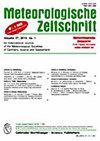Calculation of aerosol particle hygroscopic properties from OPC derived PM2.5 data
IF 1.2
4区 地球科学
Q4 METEOROLOGY & ATMOSPHERIC SCIENCES
引用次数: 0
Abstract
Hygroscopic growth of aerosol particles due to increasing relative humidity in the atmosphere is characterized by their hygroscopicity parameter κ and their hygroscopic growth factor GF. A technique to calculate the two using PM2.5 data from two optical counting sensors is examined. Only one of the two instruments is equipped with a drying channel, and therefore differences between ambient and dry air concentrations can be observed when both are working simultaneously. Based on the definition of the hygroscopic growth factor as the ratio between an aerosol particle's wet and dry diameter, a relationship including PM values is reached through the assumption of particle spherical shape and basic geometry. Aerosol particles from marine and urban sources were sampled during a week of measurements in two locations, in Norderney, Germany during April 2021 and in Rødby, Denmark, during September 2022. Calculated GF and κ values were related to the origin of the air-mass using back trajectory modeling (NOAA HYSPLIT) and by comparing the results to their expected values and fits on theoretical growth curves. It was found that κ = 0 . 6 ± 0 . 1 $\kappa =\nobreak 0.6 \pm\nobreak 0.1$ when continental air was sampled (agreeing with ammonium sulphate's κ = 0 . 6 1 $\kappa =\nobreak 0.61$ ) and κ = 1 . 1 ± 0 . 1 $\kappa =\nobreak 1.1 \pm\nobreak 0.1$ when marine air was sampled (agreeing with sea salt's same value). The GF estimates also matched their respective expected values within a deviation of 1σ. For the measurements in Rødby, particle number size distributions for the cases of marine sourced concentrations showed a peak at 1 to 2 μm, which is similar to previous studies of Baltic sea aerosol particle size distribution and structure.根据 OPC 得出的 PM2.5 数据计算气溶胶颗粒的吸湿特性
大气中相对湿度增加导致气溶胶粒子吸湿性增长的特征是其吸湿性参数 κ 和吸湿性增长因子 GF。本文研究了利用两个光学计数传感器的 PM2.5 数据计算这两个参数的技术。两台仪器中只有一台配备了干燥通道,因此当两台仪器同时工作时,可以观察到环境和干燥空气浓度之间的差异。根据将吸湿性增长因子定义为气溶胶颗粒干湿直径之比,通过假设颗粒的球形和基本几何形状,得出了包括可吸入颗粒物数值的关系。2021 年 4 月在德国诺德尼和 2022 年 9 月在丹麦罗德比对海洋和城市来源的气溶胶粒子进行了为期一周的采样测量。利用后向轨迹建模(NOAA HYSPLIT)将计算出的 GF 和 κ 值与空气质量的来源联系起来,并将结果与预期值和理论增长曲线拟合值进行比较。结果发现,κ = 0 . 6 ± 0 .1 $\kappa =\nobreak 0.6\pm\nobreak 0.1$ (与硫酸铵的 κ = 0 .1 ± 0 .1 $\kappa =\nobreak 1.1 \pm\nobreak 0.1$(与海盐的相同值一致)。GF 估计值也与各自的预期值吻合,偏差在 1σ 以内。在 Rødby 的测量中,海洋来源浓度情况下的粒子数粒径分布显示出 1 到 2 μm 的峰值,这与之前对波罗的海气溶胶粒径分布和结构的研究相似。
本文章由计算机程序翻译,如有差异,请以英文原文为准。
求助全文
约1分钟内获得全文
求助全文
来源期刊

Meteorologische Zeitschrift
地学-气象与大气科学
CiteScore
2.80
自引率
8.30%
发文量
19
审稿时长
6-12 weeks
期刊介绍:
Meteorologische Zeitschrift (Contributions to Atmospheric Sciences) accepts high-quality, English language, double peer-reviewed manuscripts on all aspects of observational, theoretical and computational research on the entire field of meteorology and atmospheric physics, including climatology. Manuscripts from applied sectors such as, e.g., Environmental Meteorology or Energy Meteorology are particularly welcome.
Meteorologische Zeitschrift (Contributions to Atmospheric Sciences) represents a natural forum for the meteorological community of Central Europe and worldwide.
 求助内容:
求助内容: 应助结果提醒方式:
应助结果提醒方式:


